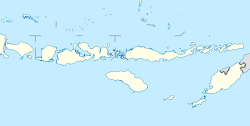Rote Ndao Regency
Rote Ndao Regency
Kabupaten Rote Ndao | |
|---|---|
 Coconut Palms on Rote Island | |
 Location within East Nusa Tenggara | |
Location in Lesser Sunda Islands and Indonesia | |
| Coordinates: 10°28′00″S 123°23′00″E / 10.4667°S 123.3833°E | |
| Country | |
| Region | Lesser Sunda Islands |
| Province | |
| Capital | Baa |
| Government | |
| • Regent | Leonard Haning |
| • Vice Regent | Jonas. C. Lun |
| Area | |
| • Land | 494.25 sq mi (1,280.10 km2) |
| Population (2015)[1] | |
| • Total | 147,379 |
| Area code | (+62) 380 |
| Website | rotendaokab.go.id |
Rote Ndao Regency is a regency in East Nusa Tenggara province of Indonesia, consisting primarily of the island of Rote, situated south-west of the western tip of West Timor. Established in 2002 formerly part of Kupang Regency, the regency has its seat (capital) in Baa. The population was 119,908 as of the 2010 census and 147,379 at the 2015 Census.[2]
The regency is surrounded by water, bordering the Savu Sea to the north, the Indian Ocean to the south and west, and the Pukuafu Strait to the east. Many Beluga whales are known to breed in this regency.
Administration
This Regency was originally composed of six districts (kecamatan), but it later underwent re-organisation into eight districts, and in 2012 into ten districts. Their areas (in km2) and their 2010[3] and 2015 Census populations are listed below.[4]:
| Name | English name | Area (in km2) |
Population Census 2010 |
Population Census 2015 |
|---|---|---|---|---|
| Rote Timur | East Rote | 110.84 | 16,633 | 14,903 |
| Landu Leko | 194.06 | 1 | 5,596 | |
| Pantai Baru | Baru Beach | 176.18 | 12,397 | 15,278 |
| Rote Tengah | Middle Rote | 162.50 | 8,058 | 9,931 |
| Rote Selatan | South Rote | 73.38 | 5,173 | 6,375 |
| Lobalain | (Busalangga) | 145.70 | 24,789 | 30,550 |
| Rote Barat Daya | Southwest Rote | 114.57 | 19,737 | 24,325 |
| Rote Barat Laut | Northwest Rote | 172.40 | 22,608 | 27,864 |
| Rote Barat | West Rote | 100.48 | 10,513 | 9,151 |
| Ndao Nuse2 | 14.19 | 3 | 3,805 |
Notes:
- 1 included in 2010 population of Rote Timur district, from the northern part of which it was cut out in 2012.
- 2 comprising the offshore Ndao Island, Nuse Island and Do'o Island.
- 3 included in 2010 population of Rote Barat district, from which it was cut out in 2012.
Islands
Rote Ndao has an area of 1,280.10 km2, including 96 offshore islands surrounding it, though only the following six are inhabited,[5] namely:
- Rote Island, area 97.854 km2;
- Usu Island, area 1.940 km2;
- Ndao Island, area 0.863 km2;
- Landu Island, area 0.643 km2; and
- Nuse Island, area 0.566 km2;
- Do'o Island, area 0.192 km2.
Sasando and Ti'i langga
The sasando (a musical instrument) and the ti'i langga (a hat) are well-known symbols of Rote Ndao Regency.
- The sasando is a Rotenese string musical instrument, found nowhere else outside East Nusa Tenggara. The instrument of 28 strings (consisted of 15 thick strings and 13 thin strings) has unique resonance. It is made from a lontar palm leaf. Originally, the sasando was called the sasando gong and consisted of fewer strings. It was later developed into the sasando biola (violin sasando) that sounds more like a harp. Performers such as Berto Pah in Indonesia Mencari Bakat usually play the sasando biola as a solo player. The sasando gong has become less popular recently. Nowadays the sasando is modified and modernized further for the comfort of traveling and public performances so that the leaf can now be folded somewhat like a hand-fan and it can be plugged to an amplifier. However, the modernized sasando is less likely to be found crafted in Rote Ndao Regency, than Timor, more specifically in Oebelo Village. In Rote Ndao there are still a few places where the sasando is taught and practised.
- The ti'i langga on the other hand, is a traditionally crafted lontar leaf hat resembling a Mexican sombrero hat. The hat is worn by male Rotenese, more so in past years, to protect them from the sun while working outside (for example, while tapping the sap of lontar trees). It is made up of lontar leaf webbings and constructed without the aid of glue, sometimes even ornamented with coloured straps that complement the Rotenese tastes of rather simple artistry.
References
External links




